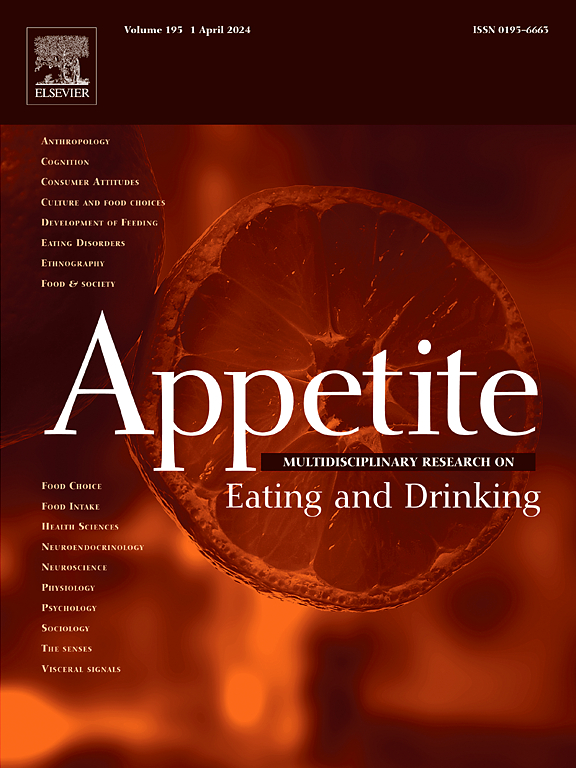Child-report food insecurity assessment measures: A scoping review
IF 4.6
2区 医学
Q1 BEHAVIORAL SCIENCES
引用次数: 0
Abstract
Background
Experiences of household food insecurity are associated with a wide range of deleterious nutritional, developmental, psychological and social consequences for children. Children's distinct experiences of food insecurity, compared to adults, have been identified in diverse economic and cultural contexts. Yet historically, measurement of food insecurity in children has been predominantly reported by adult respondents on behalf of children, potentially underestimating prevalence and neglecting their unique perspectives. In response to this, child-report measures have been developed to assess food security status at both the individual and household level.
Objectives
To identify and characterise child self-report food insecurity assessment tools used globally, with particular interest in how children's perspectives have been included in measure development processes.
Methods
A scoping systematic literature review was conducted using PRISMA-ScR. Searches were conducted in four databases in January 2024 using keywords and MeSH terms. Data were extracted and synthesised relating to population and measure characteristics, validity and reliability metrics, and child involvement in measure development.
Results
A total of 169 papers employing child-report measures were included after screening. Most papers originated in North America, used a single-item and included children aged >12 years. Of the child-report measures identified (n = 33), most were not specifically validated in the population of use. Only a small number of included papers (n = 13) had the aim to specifically evaluate measure validity. The Child Food Insecurity Experiences Scale and Child Food Assessment Scale emerged as child-centred measures with comprehensive validity evidence.
Conclusions
Further child-centred validity testing, particularly with younger children (<12 years) is necessary to ensure validity of measures across age-groups and contexts. Ethical considerations when employing child-report measures, including how to best use tools across different child settings also warrant further exploration.
儿童报告粮食不安全评估措施:范围审查。
背景:家庭粮食不安全的经历与对儿童的各种有害营养、发育、心理和社会后果有关。与成年人相比,儿童在粮食不安全方面的独特经历已在不同的经济和文化背景下得到确认。然而,从历史上看,对儿童粮食不安全状况的衡量主要是由代表儿童的成人受访者报告的,这可能低估了普遍情况,并忽视了儿童的独特观点。为此,制定了儿童报告措施,以评估个人和家庭两级的粮食安全状况。目标:确定和描述全球使用的儿童自我报告粮食不安全评估工具,特别关注如何将儿童的观点纳入衡量发展过程。方法:采用PRISMA-ScR进行大范围系统文献综述。2024年1月在四个数据库中使用关键词和MeSH术语进行检索。提取并综合了与人口和测量特征、有效性和可靠性指标以及儿童参与测量发展有关的数据。结果:经筛选,共纳入采用儿童报告方法的论文169篇。大多数论文来自北美,使用单一项目,包括年龄在10到12岁之间的儿童。在确定的儿童报告措施中(n=33),大多数没有在使用人群中特别验证。只有少数纳入的论文(n=13)的目的是专门评估测量效度。儿童粮食不安全经历量表和儿童粮食评估量表作为以儿童为中心的措施,具有全面的效度证据。结论:进一步以儿童为中心的效度测试,特别是对年幼的儿童(
本文章由计算机程序翻译,如有差异,请以英文原文为准。
求助全文
约1分钟内获得全文
求助全文
来源期刊

Appetite
医学-行为科学
CiteScore
9.10
自引率
11.10%
发文量
566
审稿时长
13.4 weeks
期刊介绍:
Appetite is an international research journal specializing in cultural, social, psychological, sensory and physiological influences on the selection and intake of foods and drinks. It covers normal and disordered eating and drinking and welcomes studies of both human and non-human animal behaviour toward food. Appetite publishes research reports, reviews and commentaries. Thematic special issues appear regularly. From time to time the journal carries abstracts from professional meetings. Submissions to Appetite are expected to be based primarily on observations directly related to the selection and intake of foods and drinks; papers that are primarily focused on topics such as nutrition or obesity will not be considered unless they specifically make a novel scientific contribution to the understanding of appetite in line with the journal's aims and scope.
 求助内容:
求助内容: 应助结果提醒方式:
应助结果提醒方式:


